Abel Tasman National Park, nestled on the sun-drenched northern tip of Aotearoa – New Zealand’s South Island, is a true coastal gem. Known for its golden sandy beaches, crystal-clear turquoise waters, and lush native bush, this compact but stunning park offers the perfect blend of outdoor adventure and serene relaxation. Whether you’re kayaking alongside curious seals, hiking forest-lined coastal tracks, or simply unwinding on a secluded beach, Abel Tasman delivers a nature experience like no other. With its mild climate, accessible trails, and a strong sense of tranquillity, it’s easy to see why this park captures the hearts of travellers from all over the world.
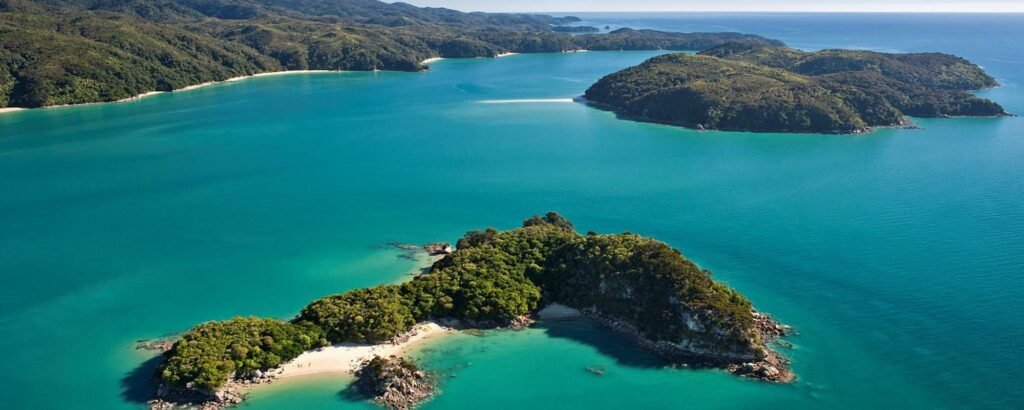
A Personal Note from Us
We absolutely love this area—there’s just something about Abel Tasman that keeps pulling us back. No matter how many hikes we’ve done or coastal towns we’ve explored, we’ve only scratched the surface. Every visit feels new. There’s always a fresh track to follow, a quiet cove to discover, or a cheeky weka to make you smile. Abel Tasman has a rare magic—it calms you down and blows you away, all at once.
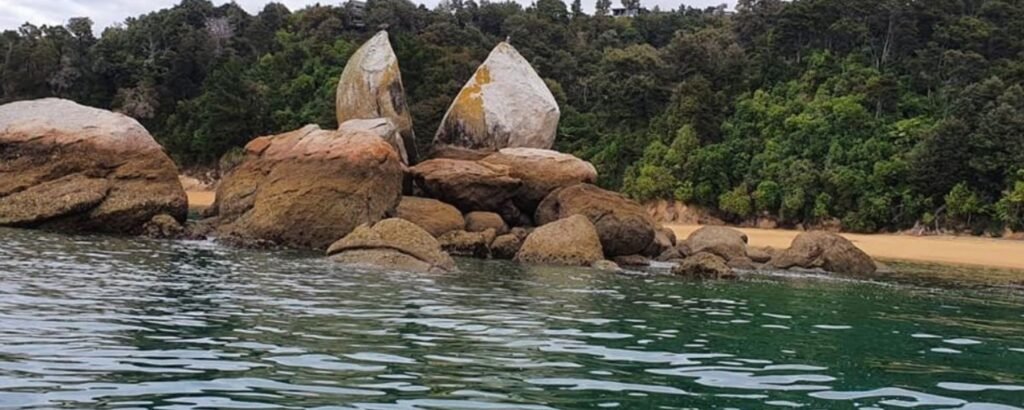
What Makes Abel Tasman So Special?
It’s the stunning blend of native bush, sandy beaches, and clear, calm waters that makes Abel Tasman so unforgettable. One moment you’re walking under a canopy of birdsong, the next you’re barefoot on sun-warmed sand, watching kayakers drift past.
This park also holds deep stories. While it takes its name from Dutch explorer Abel Tasman, the land has long been part of Māori heritage. Along the coastal track, you’ll spot many place names in te reo Māori—each with its own meaning, tied to the whenua (land), ancestors, and natural rhythms of the area.
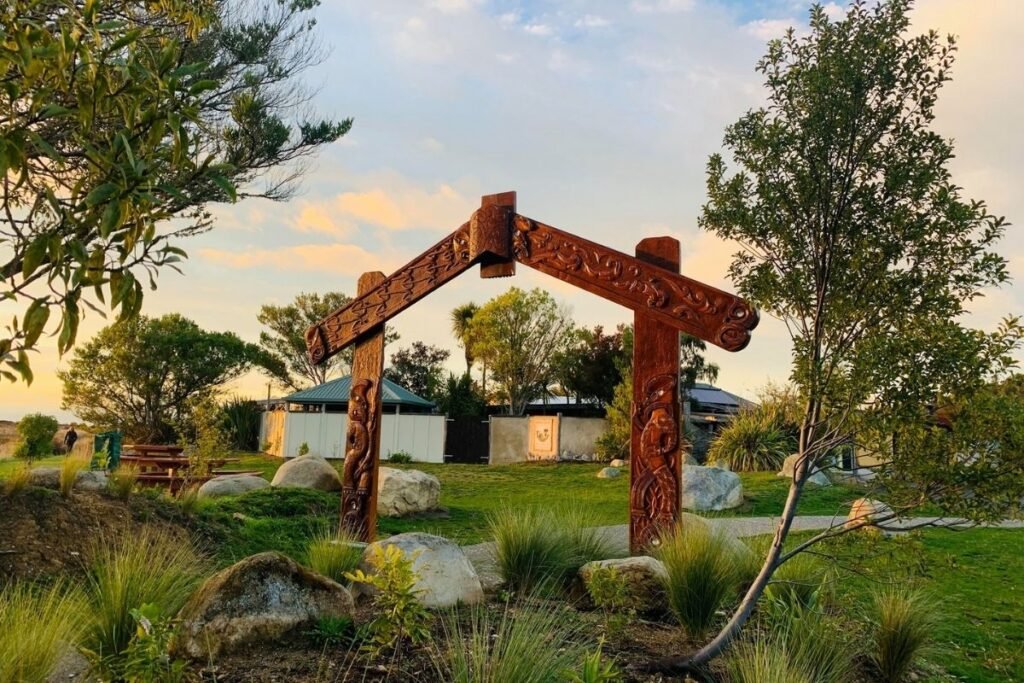
Kahurangi — Māori Meaning
You might hear the name “Kahurangi” used nearby, but it refers to a separate national park. In te reo Māori, kahurangi means “treasured possession,” which is fitting—but not the original name for Abel Tasman.
Abel Tasman National Park sits within the rohe (tribal area) of Ngāti Rārua, Ngāti Tama, and Te Ātiawa. Their deep connection to this land is ever-present. You’ll find traces of their stories woven into place names and signs throughout the park. It’s not just about scenic views—this place has a heartbeat and a history.
Table of Contents
- A Personal Note from Us
- What Makes Abel Tasman So Special?
- Kahurangi — Māori Meaning
- 10 Can’t-Miss Experiences in Abel Tasman National Park
- Best Areas and Places to Stay in Abel Tasman
- Where to Eat in Abel Tasman – Personal Picks & Crowd Pleasers
- The Best Trails in Abel Tasman: From Relaxing Walks to Challenging Hikes
- Prime Spots for Sunrise and Sunset in Abel Tasman
- Getting to Abel Tasman: Tips and Routes
- 5 Fascinating Facts About Abel Tasman National Park
Top 10 Experiences in Abel Tasman National Park
Designed to accommodate everyone, from novices to seasoned kayakers, these tours offer a unique blend of adventure and tranquillity. The highlight of this experience is a moment of profound peace as dusk turns to night, with the first stars appearing in the sky, creating memories that linger long after the journey ends. Discover the pristine beauty of Abel Tasman National Park with a variety of water-based activities.
We usually start with Viator and Get Your Guide when planning tours or activities — both are easy to use and have loads of trusted options. But we always check Tripadvisor too, as it’s packed with local gems and more traveller reviews.
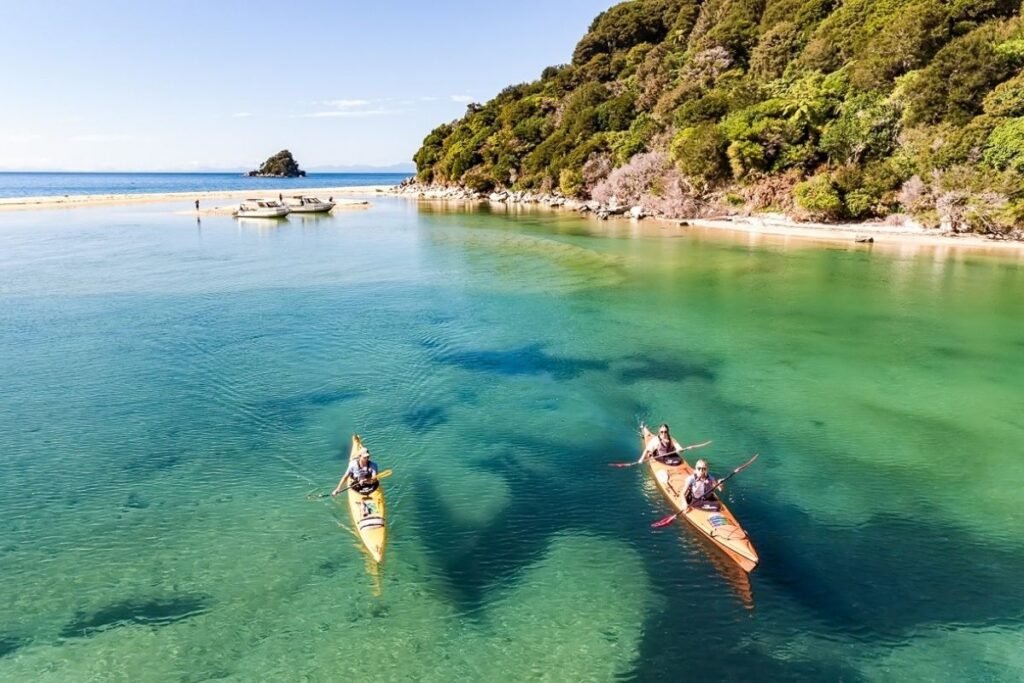
Coastal Adventures
These are the best ways to experience Abel Tasman’s iconic coastline from the water.
- Cruising the Coast:
- A scenic cruise along Abel Tasman’s shoreline is one of the best ways to soak in the park’s pristine beauty. Glide across calm, turquoise waters past golden beaches, hidden coves, and lush bush-covered hills. The sea breeze and rhythmic waves create a peaceful atmosphere as you explore the coastline from a different perspective. Expect postcard-perfect views of iconic spots like Anchorage Bay and Adele Island. Many cruises offer commentary on the region’s history and ecology, and you might even spot dolphins leaping beside the boat. It’s a relaxing and informative way to start your Abel Tasman adventure.
- Kayaking Adventures:
- Kayaking here is unforgettable. Paddle through clear waters at your own pace, weaving through quiet lagoons, rocky outcrops, and sheltered bays. Some areas are only accessible by kayak, giving you a more intimate look at the coastline. It’s common to see seals swimming nearby or birds diving for fish. Whether you’re a beginner or experienced paddler, kayaking offers a sense of freedom and connection with nature that’s hard to beat.
- Sunset Kayak Tours:
- There’s no better way to end a day than on a sunset kayak tour. As the sun dips low, the sky turns vibrant shades of orange, pink, and gold, reflecting on the water and casting soft light over the coastline. It’s peaceful, visually stunning, and deeply memorable—an experience that perfectly captures the magic of Abel Tasman National Park.
Explore on Foot
Discover the natural beauty of Abel Tasman’s trails and native bush.
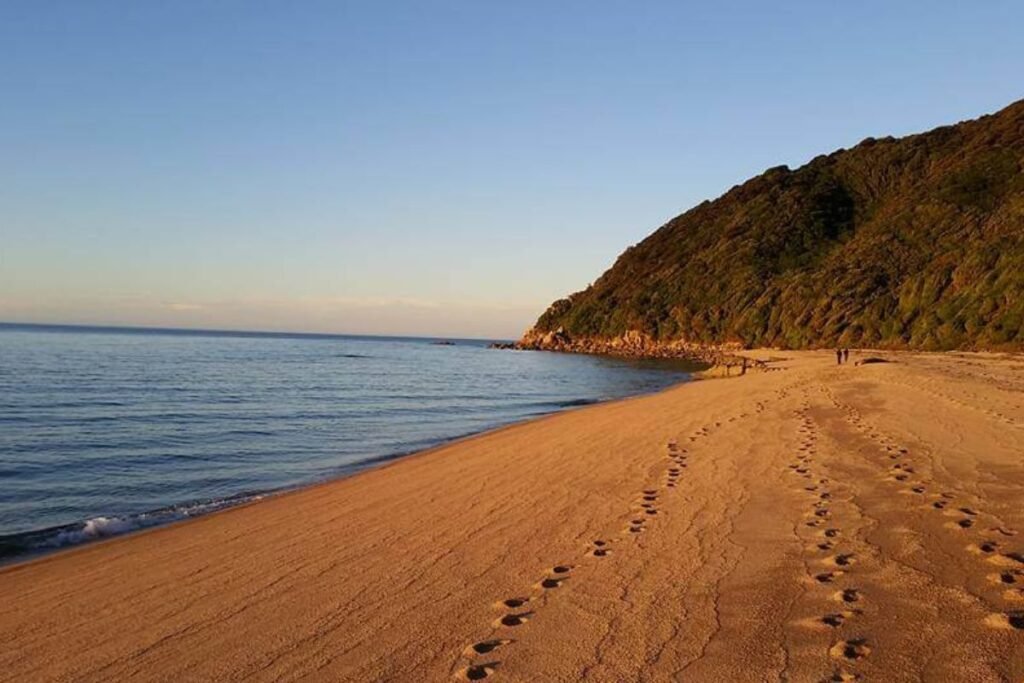
- Hiking the Coast Track:
- The Abel Tasman Coast Track is one of Aotearoa – New Zealand’s Great Walks, and rightly so. This 60 km trail meanders through native forest, over swing bridges, and alongside golden-sand beaches. Some sections are easy and flat, while others include gentle hill climbs, offering variety for all fitness levels. You’ll pass through forests filled with mānuka, wetlands rich in birdlife, and scenic lookouts with sweeping views. With well-maintained huts and campsites along the way, you can hike a short section or plan a multi-day journey through this coastal paradise.
- Photography Walks:
- Golden beaches, green forests, dramatic cliffs—Abel Tasman is a photographer’s dream. The changing light through the day makes each scene feel new. Whether you’re capturing sunrise reflections, detailed close-ups of ferns, or panoramic views from a lookout, there’s endless inspiration here. Join a guided photo tour or take your time wandering with a camera in hand.
Wildlife Encounters
Keep your eyes peeled, Abel Tasman is full of native creatures in their natural habitat.
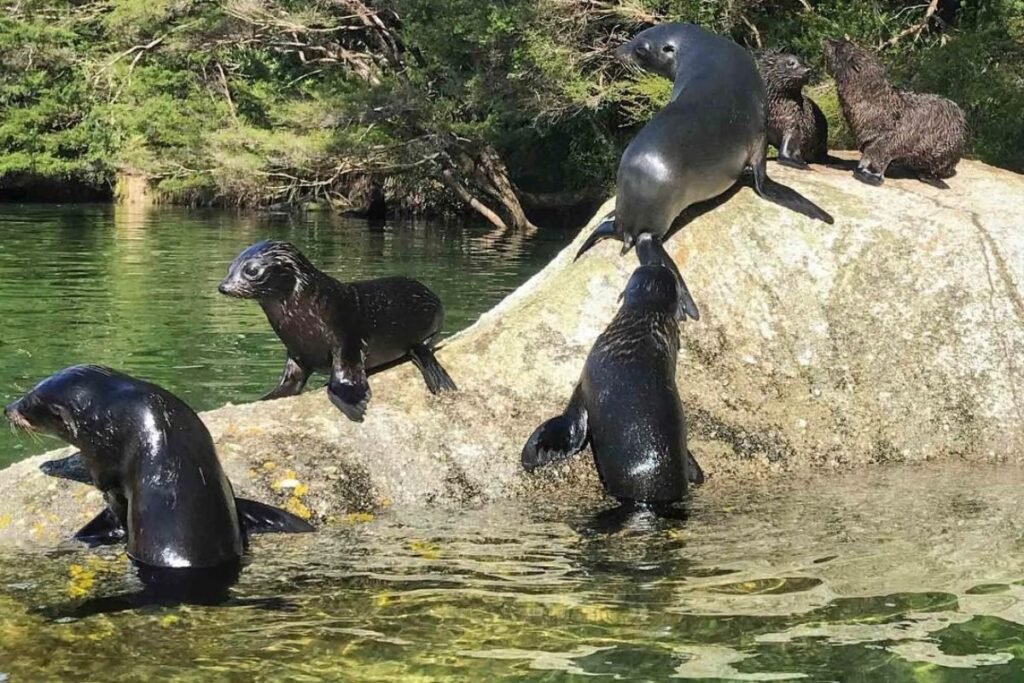
- Seal Watching at Tonga Island:
- Tonga Island is home to a thriving colony of fur seals. As you approach by boat or kayak, you’ll likely spot them sunbathing on rocks or gliding through the waves. They’re naturally curious and may swim close, offering a rare chance to watch them up close without disturbing their space. This wildlife encounter highlights the park’s rich marine biodiversity. Just remember to keep a respectful distance—this is their home, and we’re the visitors.
- Birdwatching:
- Abel Tasman is a bird lover’s dream. The forest and estuaries are alive with native birds like tui, bellbirds, fantails, and weka. Their songs create a beautiful natural soundtrack as you explore. Bring binoculars and a bird guidebook if you’re keen to identify what you see. Whether you’re an experienced birder or simply love nature, spotting native species in their habitat adds another layer to your visit.
Chill & Stay Awhile
Slow down and take in the serenity of this coastal wonderland.
- Beach Hopping:
- With so many incredible beaches, it’s hard to pick just one. From popular spots like Anchorage and Bark Bay to quieter gems like Totaranui and Onetahuti, each beach offers something different. Many are accessible via the Coast Track, so you can walk from one to the next. Swim, sunbathe, explore rock pools, or just enjoy the peaceful setting. It’s the ultimate coastal experience.
- Camping Under the Stars:
- There’s something magical about camping in Abel Tasman. Choose from forested clearings, beachfront campsites, or hilltop sites with sweeping views. As night falls, the forest comes alive with sound and the sky reveals a blanket of stars. DOC-maintained campsites range from basic to more equipped, offering something for everyone. Book ahead, especially in summer, and wake up to birdsong and sea breeze in one of the most peaceful places imaginable.
Cultural & Historical Sites
Abel Tasman holds stories of the past—both Māori and European.
- Exploring Historical Sites:
- Abel Tasman holds centuries of history. Discover remnants of Māori pā (fortified villages), early European settlement sites, and learn about the first encounters between cultures. Interpretive signs and guided tours help tell the story behind the landscape. These historical sites add cultural depth and context to the natural beauty around you.
Best Areas and Places to Stay in Abel Tasman
When it comes to finding the right place to stay, we usually start with Trip.com — it’s easy to use and covers everything from budget motels to boutique stays and self-contained options. We also like to check Tripadvisor for reviews and side-by-side comparisons and Booking.com is a handy tool for comparing prices across multiple platforms. Between them, you’ll get a clear picture of what’s available and what might suit your travel style best.
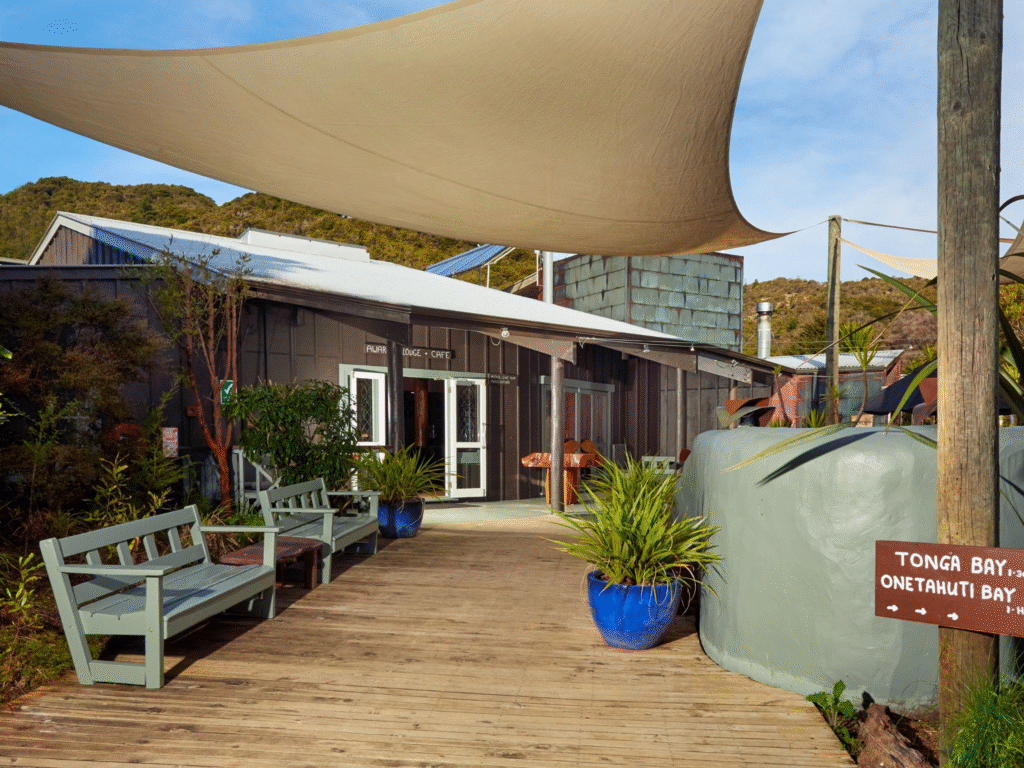
- Awaroa Bay Bliss:
- Tucked deep within Abel Tasman National Park, Awaroa Bay Bliss is a luxurious eco-lodge set against a backdrop of golden sand, native bush, and tranquil waters. This secluded retreat is accessible only by boat, water taxi, or helicopter, making it one of the most exclusive and peaceful escapes in the region. Whether you’re soaking in the panoramic views from your private deck or dining on gourmet local cuisine, this is the ultimate remote getaway for those craving privacy, romance, and a deep connection with nature.
- Marahau Mews:
- For travellers who want to be right at the doorstep of adventure, Marahau Mews offers comfortable and stylish accommodation just minutes from the Abel Tasman Coast Track trailhead. Located in the relaxed coastal village of Marahau, you’ll be within easy walking distance of kayaking tours, water taxis, cafés, and beaches. It’s a great choice for those wanting convenience without compromising on charm, and a perfect base for both day hikes and multi-day park explorations.
- Kaiteriteri Reserve Cabins:
- These affordable, no-frills cabins are ideal for budget-conscious travellers who want to stay near one of the South Island’s most iconic beaches. Set within the scenic Kaiteriteri Recreation Reserve, the cabins offer simple but comfortable facilities — all just a short stroll from the golden sands and calm swimming waters. With a beachside café, bike trails, and boat tours nearby, it’s a great base for families, groups, or couples who want easy access to everything without breaking the bank.
Where to Eat in Abel Tasman – Personal Picks & Crowd Pleasers
These suggestions are based on places we’ve dined at, trusted tips from whānau and friends, and plenty of online sleuthing. Whether you’re after a hearty meal or a relaxed beachside drink, here are some top local spots
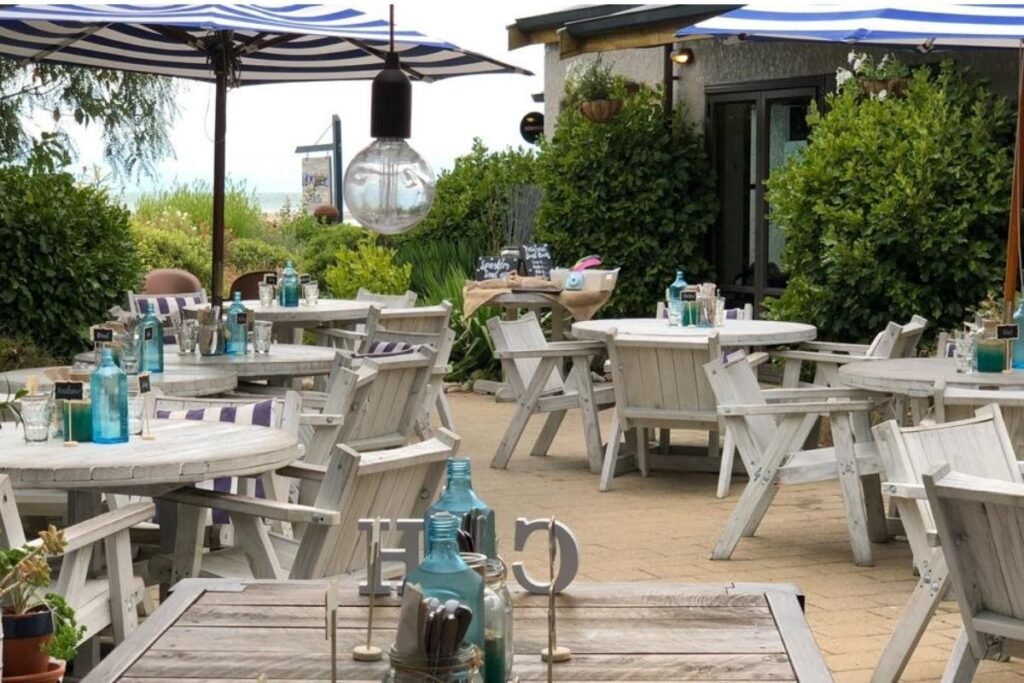
- Hooked on Marahau:
- Right at the gateway to Abel Tasman National Park, this waterfront café, beer garden, and restaurant offers unbeatable views over Tasman Bay. Open since 2002, it’s a favourite for locals and visitors alike. Hooked serves breakfast, lunch, and dinner with an emphasis on fresh, locally sourced ingredients. Don’t miss their happy hour from 4–6 PM, featuring craft beers and regional wines.
- The Beached Whale Restaurant & Bar:
- Located in Kaiteriteri, this casual seaside spot is known for its warm Kiwi hospitality and wood-fired pizzas. The à la carte menu includes local favourites, and there’s a takeaway option too. With regular live music and a laid-back vibe, it’s a great place to unwind after a day in the park.
- Kaiteriteri Beach Café:
- Set right on the sand, this is the perfect place for a relaxed lunch or early dinner. The menu ranges from fresh salads and sandwiches to heartier meals, all made with locally sourced produce. It’s an easy, breezy option with stunning beachfront views.
- The Mussel Inn:
- A little further out but well worth the drive, The Mussel Inn is a local legend. Known for its fresh, green-lipped mussels, craft beers brewed on-site, and rustic charm, it’s a great stop for foodies and beer lovers alike.
Hiking the Abel Tasman Coast Track
One of the best ways to explore the park’s wild beauty is on foot. The Abel Tasman Coast Track is world-famous, but there are also shorter trails for day walkers and families. From forest-covered hills to swing bridges and hidden beaches, these hikes deliver it all.
Here are a few standout walks:
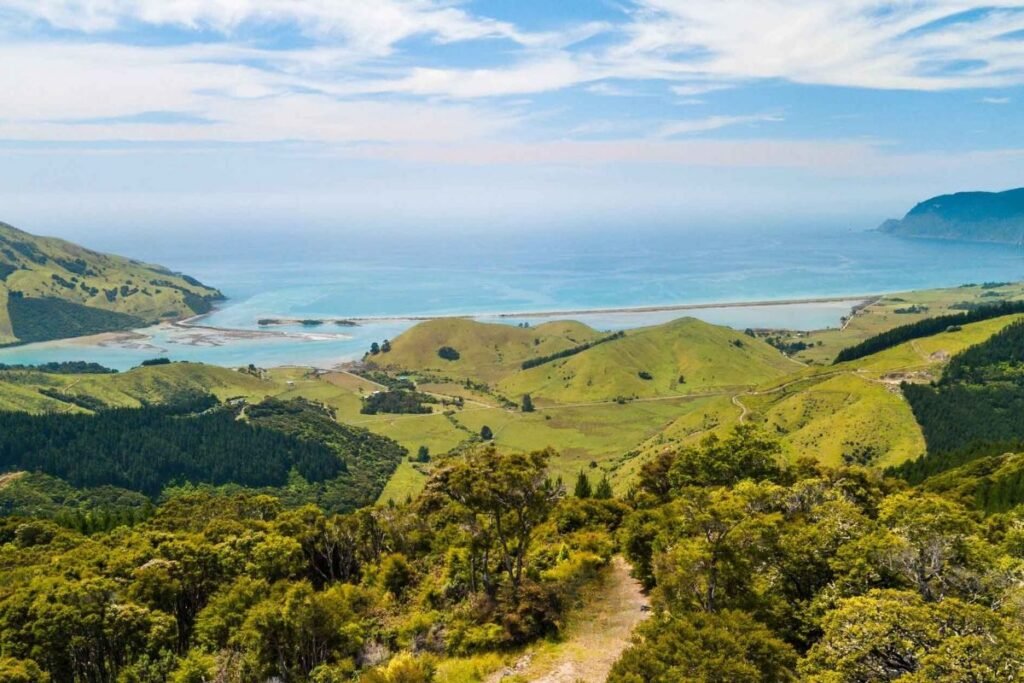
Abel Tasman Coast Track
- Difficulty: Moderate
- Length: 60 km (3–5 days)
- This is the park’s signature trail — stretching from Mārahau to Wainui Bay. It weaves through lush bush, golden beaches, and tidal estuaries. Perfect for both day hikes and multi-day treks, with huts and campsites along the route. Bookings are essential from October to April.
Wainui Falls Track
- Difficulty: Easy
- Length: 3.4 km (1.5 hours return)
- A short and family-friendly walk to the largest waterfall in the region. The trail crosses a swing bridge and winds through native bush alive with birdsong. No booking required.
Totaranui to Awaroa
- Difficulty: Moderate
- Length: 5.5 km (2 hours one way)
- This gentle coastal trail connects two stunning beaches. It offers incredible views, forest shade, and the option to return via water taxi. Great for a half-day outing.
Bark Bay to Torrent Bay
- Difficulty: Moderate
- Length: 7.4 km (2.5–3 hours one way)
- One of the most scenic sections of the Coast Track. You’ll cross the impressive Falls River Swing Bridge and pass by several quiet coves perfect for a swim. Bookings required for overnight stays.
Gibbs Hill Track
- Difficulty: Hard
- Length: 11.2 km (5 hours one way)
- A lesser-known gem offering sweeping views over Golden Bay and the Tasman Sea. This one’s steeper and more rugged — perfect for experienced hikers looking to escape the crowds. No booking needed.
Before you hit the trail, it’s always a good idea to check the DOC (Department of Conservation) website. You’ll find important updates on track conditions, weather alerts, and any closures or hazards. It’s also where you can book huts or campsites on popular multi-day hikes. Checking in first helps you stay safe, pack what you need, and enjoy your adventure with confidence — especially in Aotearoa’s wild and changeable backcountry.
👉 For even more inspiration, check out our full guide to Discover Aotearoa-New Zealand’s Most Breathtaking Hikes.
Prime Spots for Sunrise and Sunset in Abel Tasman
Abel Tasman National Park is one of the best places in Aotearoa – New Zealand to watch the sun rise or set. Golden beaches, lush headlands, and sweeping sea views make for unforgettable moments. Below are our top picks, divided into sunrise and sunset spots.
Whether you’re an early riser or a sunset chaser, remember to check tide times, track conditions, and park access—especially if you’re visiting in the twilight hours.
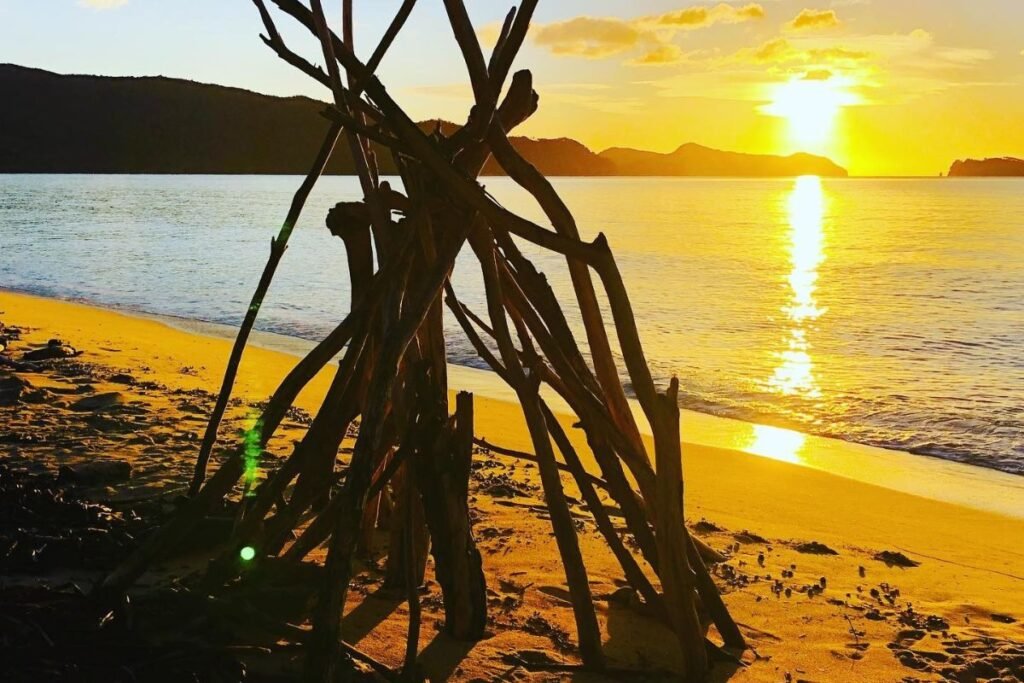
Top Sunrise Spots
- Totaranui Beach: This long, east-facing beach is ideal for an early start. Watch as the first light washes over golden sands and calm waters, creating a tranquil and awe-inspiring beginning to your day.
- Observation Beach: A quieter alternative, Observation Beach offers a clear view of the eastern horizon. It’s a fantastic spot to sit with a warm drink and take in the stillness of the morning sea.
- Bark Bay: Accessible via the Abel Tasman Coast Track, Bark Bay captures the sunrise beautifully. The morning light lights up both the beach and surrounding native bush, making it a photographer’s dream.
Top Sunset Spots
- Awaroa Bay: In the heart of the park, Awaroa Bay delivers a peaceful, almost magical sunset experience. Watch the light shift across the water as the sun sinks low, casting warm reflections across the bay.
- Pitt Head: A short walk from Te Pukatea Bay, this elevated lookout gives you sweeping views over the coastline. As the sun dips below the sea, the colours over the surrounding bays are unforgettable.
- Apple Tree Bay: Tucked away in a quieter part of the park, Apple Tree Bay is perfect for a peaceful end to the day. The sun sets behind the hills, and the soft waves make it feel like your own private retreat.
Getting to Abel Tasman: Tips and Routes
Abel Tasman National Park sits at the northern tip of Aotearoa – New Zealand’s South Island. Whether you’re arriving by plane, car, ferry, or bus, getting here is part of the adventure. Here’s how to make the journey smooth and stress-free.
Flying to Nelson, hiring a car and driving to Abel Tasman
Driving to Abel Tasman
- From Whakatū – Nelson: Nelson is the closest city, just an hour’s drive away. Head out on State Highway 6, then turn onto State Highway 60 (the Coastal Highway) at Waimea – Richmond. Continue through Motueka, and follow signs to one of the park’s main access points: Kaiteriteri, Mārahau, or Totaranui.
- From Waitohi – Picton (via ferry): If you’re arriving from the North Island, it’s a 2–3-hour scenic drive from the ferry terminal in Picton. Take State Highway 1 to Te Waiharakeke – Blenheim, then follow SH6 to Waimea – Richmond and continue as above.
- Parking Tips: In peak season, parking at Mārahau and Kaiteriteri can fill up fast. Aim to arrive early, especially if you’re catching a water taxi or joining a tour. Alternatively, look into shuttle options.
🚐 Need a Campervan for Your Journey?
Looking to explore Aotearoa – New Zealand by road? Start by comparing motorhome options with Motorhome Republic. It’s a simple way to find the best fit for your travel style — whether you’re after a cosy van for two or a fully equipped home on wheels.
Public Transport Options
- Bus Services: Regular buses run from Whakatū – Nelson, Waimea – Richmond, and Motueka to key entry points like Mārahau and Kaiteriteri. These are reliable during the main visitor season.
- Shuttle Transfers: Private shuttle services also operate from Nelson and nearby towns. They’re a convenient option if you don’t have a car or want a one-way hike along the Coast Track.
5 Fascinating Facts About Abel Tasman National Park
Here are a few quick facts to impress your travel buddies — or to simply deepen your appreciation for this beautiful part of Aotearoa – New Zealand.
- Named After a Dutch Explorer: The park is named after Abel Tasman, the first European to sight Aotearoa – New Zealand in 1642. Interestingly, he never actually set foot on land here.
- Aotearoa’s Smallest National Park: Abel Tasman may be the smallest of New Zealand’s national parks, but it’s packed with biodiversity, scenic beauty, and unforgettable adventures.
- Home to Split Apple Rock: One of the most photographed landmarks in the region, Split Apple Rock is a large granite boulder split in two — naturally shaped like a giant apple.
- Rich Marine Life: The park includes a protected marine reserve, home to seals, dolphins, penguins, and a wide variety of fish species. Snorkelling and kayaking offer the best views of this underwater world.
- Deep Māori History: The area has been home to Māori for over 500 years. Many sites throughout the park reflect this rich cultural heritage and are still significant to local iwi today.
🌍 Travel Planning Resources
These are the tools we personally use and trust when planning our travels from finding a place to stay to booking activities, transport and insurance. Let your Tohu guide you — Trust the Journey and follow what feels right for you.
- ✈️Flights – Compare great deals with Trip.com then Kiwi.com for flexible, affordable options.
- 🚐 Campervans – Compare rental deals with Motorhome Republic across Aotearoa and beyond.
- 🛏️ Stays – Compare hotels on Trip.com and TripAdvisor or Booking.com.
- 🚐 Rental Cars – Compare prices and book through Airport Rentals by Motorhome Republic for trusted brands and easy airport pickup.
- 🎟️ Activities – Browse tours and experiences on Viator, Get Your Guide, or TripAdvisor
- 🚆12Go Asia – Compare and book trains, buses, and ferries across Asia in one place with 12Go.
- 🛡️ Travel Insurance – Get flexible short-term coverage with Insubuy for your next holiday.
- 🔒 Protect Your Privacy with a VPN – We recommend Surfshark VPN for secure and private browsing while travelling. It’s fast, affordable and works worldwide — perfect for public Wi-Fi at airports, cafes and hotels.
- 📱 Travel eSIM – Stay connected with Airalo
- 💼 Lounge Access – Treat yourself with Priority Pass – for UK or US
- 🎶 Events & Concerts – Book tickets worldwide through Ticketmaster.
🧭 Note: Some booking links can be a bit shy when you’re using a VPN. If one doesn’t open, try pausing your VPN or switching to a different server location or secure Wi-Fi network to get things flowing again.
Waiho i te toi poto, kaua i te toi roa
Let us be close together, not far apart